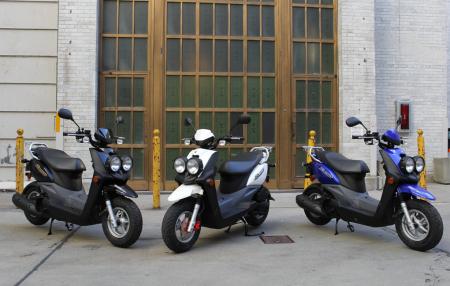 |
| Top 2013 Yamaha Zuma 50F Review |
economical at a claimed 123 mpg, its powerplant didn’t make Mother Nature happy, nor did it provide much torque. Over time, owners complained that the seating position was sloped too far forward, placing a lot of weight on the arms. That problem was exacerbated with a pillion on board.
The new 2012 Yamaha Zuma 50F in its three color options, Raven, Alpine White and Team Yamaha Blue. While they may appear the same as the old model, there are some subtle but significant changes. |
So was born the 2012 Yamaha Zuma 50F. At first glance the 50F doesn’t appear to be much different from the model it replaces. Blame it on the focus groups. They helped dictate the direction of the third-generation Zuma’s styling. They indicated that styling and fuel mileage were the two biggest factors when determining which scoot to buy. Yamaha showed these focus groups a myriad of different design sketches ranging from radical to subdued, and as the elimination process progressed, a pattern emerged: the twin bug-eye headlights from the previous model were huge hits that shouldn’t be touched, and clean, comfortable and simple styling was preferred over “plasticky,” sharp designs.
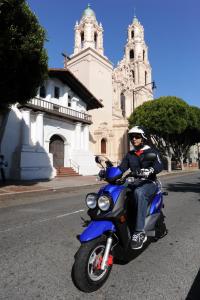 |
| Top 2013 Yamaha Zuma 50F Review |
The new Zuma 50F is a great tool for checking out San Francisco landmarks.
The end result is a machine that looks much like its predecessor. The fact that other styling cues were carried over makes the old and new even harder to distinguish. It’s not until you look closely that you notice the slight tweaks. The side panels and front fender are reminiscent of dirt bikes, while the knobby-ish tires and easily replaceable tube-type handlebar inspire some semblance of off-road pretenses. All are similar to their counterparts on the outgoing model, but aren’t quite the same.The biggest styling difference with the new Zuma and the old is in the ergonomics. Where the old model had the rider and passenger sloped forward, the 50F comes with a flatter, broader seat that lends to roomier ergos for both rider and passenger.
With the looks of the new Zuma out of the way, getting more mileage out of the tiny engine was the next task. Of course the biggest difference overall compared to the previous model is the all-new powerplant. Gone is the 49cc two-stroke and in its place is a SOHC, liquid-cooled, three-valve four-stroke engine of the same displacement. It also sports fuel injection and roller rocker arms for reduced friction. An automatic CVT transmission takes care of shifting duties, and best of all, at least as far as Mother Nature is concerned, it’s much cleaner burning. Yamaha claims more torque and better throttle response compared to the two-stroke. Fuel misers will rejoice in the fact the Zuma 50F gets even better mileage than before — to the tune of 132 miles per gallon (claimed). No, that’s not a typo.
Further changes include moving the 1.2-gallon fuel tank to the center floorboard tunnel instead of underneath the seat. This in turn lowers the center of gravity for better handling and frees up space in the under-seat storage compartment, which now holds 23 liters of stuff. Other convenience bits include an integrated cup holder, a fold-out hook to hold things like groceries, and a rear luggage rack and grab bar to strap down bigger (though not too big) items.
The seating position on the new Zuma is much more neutral compared to the outgoing model, a feature that makes all-day riding very comfortable. |
Yamaha chose to invite the press to San Francisco to get a taste of the new Zuma 50F in one of the harshest environments for scooters. If you know San Francisco at all, then you know what I’m talking about. This town is filled with steep hills that punish engines. On top of that, Yamaha arranged a scavenger hunt for the assembled journalists that included stops in every corner of the city. Not only would the Zuma’s hill-climbing ability be tested (often), but its maneuverability through traffic would be put to the test as well.
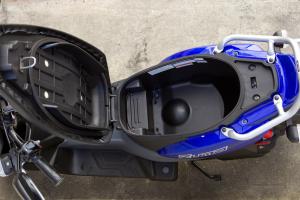 |
| Top 2013 Yamaha Zuma 50F Review |
With the fuel tank relocated to the floorboard area, a lot of room was freed up underneath the seat for storage. Enough, even, for a full-face helmet. Note also the passenger grab rail and luggage rack to the rear of the scooter.
While I admit that I haven’t spent considerable time on the old model, I do remember the seating position to be a little sloped. As promised, that’s no longer the case on the new Zuma. The seat is in fact flatter with less weight placed on the arms. As a result, seat height is a smidge taller than the old model at 30.7 inches (compared to 30.1 inches), but my 5-foot, 8-inch frame had no problems putting both feet on the ground solidly. Ergos aside, the main thing on the mind of all the journos in attendance was the engine. How would it perform? Well, with a top speed of 40 mph I wasn’t expecting much, and there’s no getting around the fact that with only 50cc the Zuma wasn’t going to win any speed contests. That said, low-end torque from the little four-stroke engine is stronger than the old two-stroke mill, evident especially when leaving a dead stop. The CVT automatic was mainly seamless except when accelerating again after coasting back down to crawling speeds.
San Francisco’s notorious inclines weren’t enough to stop the little Zuma, but don’t expect to scale them in any hurry. More often than not you’ll have to concede to bigger, faster vehicles. |
It should go without saying that the 50F only has two speeds — stopped or wide open. The latter is the case especially when trying to negotiate San Francisco’s notorious inclines. Without much room for a running start in most cases, the Zuma could manage a best of 15 mph up the steep grades, throttle cables stretched to the max. On flat ground, the 40 mph indicated top speed is attainable, but it takes around 15 seconds or so to get there.
Dashing through town to get from one checkpoint to the other, the Zuma is largely able to hold its own, though the struggle is finding the power needed to accelerate to merging speed when joining the flow of traffic.
 |
| Top 2013 Yamaha Zuma 50F Review |
Suspension, wheels and tires are holdovers from last year. Ride quality is actually quite comfortable considering the basic suspension. More impressive is the 185mm wave-type brake disc that brings the Zuma to a stop quickly.
Considering my lack of seat time on the previous model, I asked others in attendance how the new four-stroke compared with the old two-stroke. All agreed that the seating position was more comfortable on the new machine. They also agreed that while the four-stroke makes more torque than the two-stroke, perceived top end felt better on the old scoot. I say “perceived” because top speed for both models peaks around the 40 mph mark. On the suspension front, the tiny telescopic fork and single rear shock worked surprisingly well. San Fran’s bumpy roads were nicely soaked up by the suspenders, and only big potholes really upset the chassis. One benefit the 50F has is its light weight and nimble handling, allowing it to dash in between cars and obstacles in the way. Another asset is its brakes. A 180mm wave-type disc is 25mm larger than last years and has great stopping power. When combined with the rear drum brake, the Zuma comes to a halt very quickly.
But Yamaha’s focus groups show that buyers of the Zuma don’t care about power or brakes. They want a practical mode of transportation that sips gas and accommodates their everyday needs. To that end the Zuma is undeniably capable. The underseat storage area swallowed up the helmet you see in these pictures, along with a jacket, gloves, and camera bag. Yamaha even claims there’s space for a full-face helmet in there, too, and I believe it. The pop-out hook features a snap closure to make sure items don’t “jump off” when hitting a bump, and the integrated cup holder is plenty big enough for a water bottle or even a Venti latte if that’s your thing (careful about the bumps with that one).
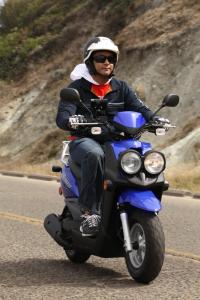 |
| Top 2013 Yamaha Zuma 50F Review |
If your transportation needs include something that’s reliable, economical and practical, the Zuma 50F could be what you’re looking for.
As far as fuel mileage goes, after an entire day of running around San Francisco at wide-open throttle, the fuel needle hardly moved. As impressive as that was, the others in attendance, including the owner of Zumaforums.net, Jon Wegener, were also impressed. Wegener informed me that the real-world mileage numbers for his two-stroke Zuma are nothing close to the 123 mpg Yamaha claims. Instead, he gets around 60 mpg on his “tuned for mileage” gen-two Zuma and noted that he would have had to refuel if he took his ride on the day’s journey. If that’s true, then college students and urban commuters all over the country should pay the Zuma 50F some close attention. Your ride has arrived. Available in Team Yamaha Blue, Alpine White and Raven, the Zuma 50F retails for $2540 and is available in dealers now. If a higher-speed scooter is required, the Zuma 125 returns for 2012 unchanged from the previous year, priced at $3350.

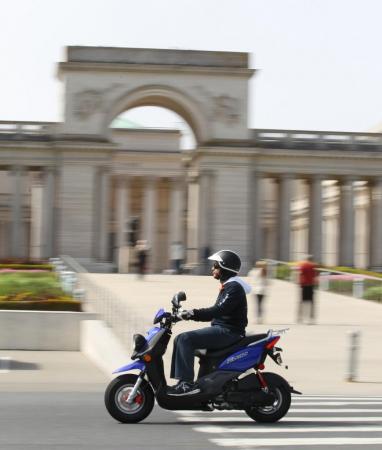
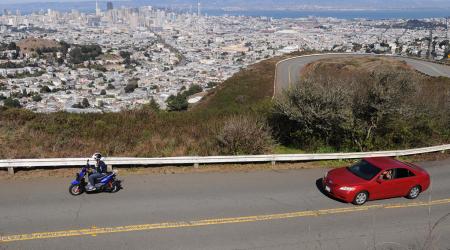
No comments:
Post a Comment